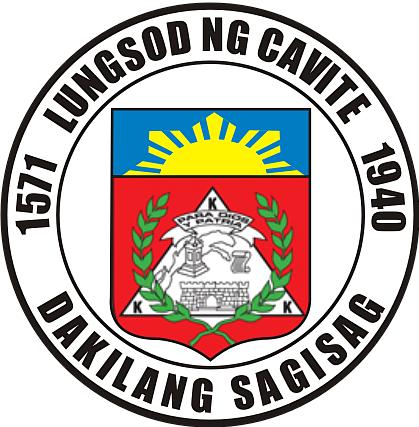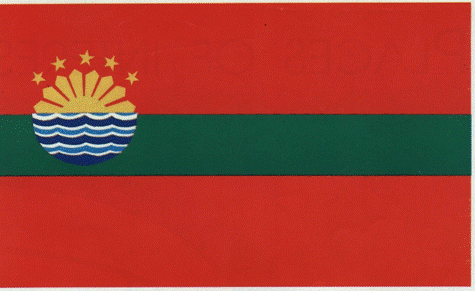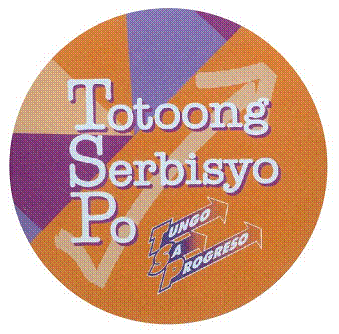Thank you for visiting... We will be adding new pages soon.
email : cavitecitymis@yahoo.com
2009. 10 . 26
email : cavitecitymis@yahoo.com
2009. 10 . 26
The Great Seal of Cavite City
- Its meaning
The shield or escudo stands for braveryand fortitude. The inclusion of the rays portrays the role of Cavite as one of the original provinces which first rose up in arms against Spanish domination during the Philippine revolution of 1896. It also describes the fact that at the western shores of the City occurs one of the most beautiful sunsets in the world. Inscribed within the escudo over the red portion is a wite triangle with the letters KKK at the corners representing the part played by Cavite City in the formation of the Katipunan. Don Ladislao Diwa of this City was one of the triumvirate who organized the patriotic group. Within the white triangle are the events represented by significant symbols as follows:
At the bottom of the triangle is a fort with "1872" which was the year of the Cavite Mutiny.
It is also the place where the 13 Martyrs were detained before they were executed.
At the background is a map of the City with the island of Corregidor which is part of the city. The heroic and epic struggle at Corregidor is part of the glorious history of the city.
The monument at left of center is in memory of the 13 Martyrs of Cavite who were executed by the Spaniards on September 12, 1896.
The musical sheet reminds us of Don Julian Felipe, composer of the Philippine National Anthem.
Inscribed on the scroll at the uppermost portion of the triangle is the motto of the City in Chabacano - "Para Dios y Patria", (for God and Country) which is "Para sa Diyos at Bayan" in Pilipino.
The laurel leaves encircling the right and left portion of the KKK triangle symbolize the victory of the people of Cavite City over adversity in times of war and peace.
The entire design is a tribute to the fortitude of the Caviteños and their willingness to sacrifice their lives, if necessary, for liberty, justice, hope, peace and progress.
- Its meaning
The shield or escudo stands for braveryand fortitude. The inclusion of the rays portrays the role of Cavite as one of the original provinces which first rose up in arms against Spanish domination during the Philippine revolution of 1896. It also describes the fact that at the western shores of the City occurs one of the most beautiful sunsets in the world. Inscribed within the escudo over the red portion is a wite triangle with the letters KKK at the corners representing the part played by Cavite City in the formation of the Katipunan. Don Ladislao Diwa of this City was one of the triumvirate who organized the patriotic group. Within the white triangle are the events represented by significant symbols as follows:
At the bottom of the triangle is a fort with "1872" which was the year of the Cavite Mutiny.
It is also the place where the 13 Martyrs were detained before they were executed.
At the background is a map of the City with the island of Corregidor which is part of the city. The heroic and epic struggle at Corregidor is part of the glorious history of the city.
The monument at left of center is in memory of the 13 Martyrs of Cavite who were executed by the Spaniards on September 12, 1896.
The musical sheet reminds us of Don Julian Felipe, composer of the Philippine National Anthem.
Inscribed on the scroll at the uppermost portion of the triangle is the motto of the City in Chabacano - "Para Dios y Patria", (for God and Country) which is "Para sa Diyos at Bayan" in Pilipino.
The laurel leaves encircling the right and left portion of the KKK triangle symbolize the victory of the people of Cavite City over adversity in times of war and peace.
The entire design is a tribute to the fortitude of the Caviteños and their willingness to sacrifice their lives, if necessary, for liberty, justice, hope, peace and progress.

The Flag of Cavite City
- Its meaning
The eight rays represent the eight provinces that first rose in revolt against Spain in 1896; one of the rays represents Cavite Province of which Cavite City is a part. Therefore, one of the rays represents the significant role played by Cavite City in unifying the nation through the Cavite Mutiny of 1872 and the 13 Martyrs Execution in 1896, and the prominent role it also played in our struggle for independence.
The two red strips symbolize the abounding courage and bravery of the Cavitenos not only in time of war but also in time of peace. The abounding courage to shed blood or even die to protect and defend their country and also to defend and die for its values and principles. It likewise symbolize and signify the abounding courage to change what needs to be changed for the better, the best and the common good. The courage and bravery to uphold the noble values, tradition and culture of our country under the principle of justice, liberty and democracy, and under the divine guidance of the everlasting God.
The middle green strip symbolizes the progress and advancement achieved by the city and the vision to achieve further progress.
The half sun represents the hope and vision of the Cavitenos for material, physical, moral and spirtitual progress. It also underlines the fact that from Cavite City can be seen one of the most beautiful sunsets in the Philippines. The five yellow stars in between the sun rays represent the five districts comprising Cavite City.
The other half of the imaginary circle below the half sun, composed of three sets of waves, in blue, light blue and white colors shows that Cavite is a peninsula surrounded by water namely the three bays of Cañacao, Bacoor and Manila Bays.
- Its meaning
The eight rays represent the eight provinces that first rose in revolt against Spain in 1896; one of the rays represents Cavite Province of which Cavite City is a part. Therefore, one of the rays represents the significant role played by Cavite City in unifying the nation through the Cavite Mutiny of 1872 and the 13 Martyrs Execution in 1896, and the prominent role it also played in our struggle for independence.
The two red strips symbolize the abounding courage and bravery of the Cavitenos not only in time of war but also in time of peace. The abounding courage to shed blood or even die to protect and defend their country and also to defend and die for its values and principles. It likewise symbolize and signify the abounding courage to change what needs to be changed for the better, the best and the common good. The courage and bravery to uphold the noble values, tradition and culture of our country under the principle of justice, liberty and democracy, and under the divine guidance of the everlasting God.
The middle green strip symbolizes the progress and advancement achieved by the city and the vision to achieve further progress.
The half sun represents the hope and vision of the Cavitenos for material, physical, moral and spirtitual progress. It also underlines the fact that from Cavite City can be seen one of the most beautiful sunsets in the Philippines. The five yellow stars in between the sun rays represent the five districts comprising Cavite City.
The other half of the imaginary circle below the half sun, composed of three sets of waves, in blue, light blue and white colors shows that Cavite is a peninsula surrounded by water namely the three bays of Cañacao, Bacoor and Manila Bays.

The Political History of Cavite City
Cavite City, which was simply called Tangway (meaning peninsula) by its natives before it was given royal encomienda in May of 1571 by Spanish conquistador Miguel Lopez de Legaspi and during the Spanish rule, was christened by the Spaniards as Cavite La Punta (being a point or a tip of land connected to a larger portion of land) to distinguish it from Kawit which was also called Cavite. When the castillians discovered Cavite La Punta to be a suitable place for the repair and construction of their ships and galleons they decided to move their settlement here and christened it anew as Cavite el Puerto (Port of Cavite) and Cavite Nuevo (New Cavite), thence, Kawit became known as Cavite el Viejo. Actually, what was considered as "Cavite" then was a big town comprising of the present-day Kawit, Noveleta, Imus and Cavite City. As the population grew, these places seceded one after the other and became independent pueblos (towns).
Kawit was founded as town in 1600, Cavite el Puerto in 1614, Imus in 1775, and Noveleta in 1867. The capital of the province was moved from Kawit to Cavite el Puerto in the year the latter was founded, San Roque was added and was founded as town also in 1614 but was placed under the civil administration of Cavite el Puerto until 1720 when it was granted a right to be a separate and an independent pueblo. Las Caridad, the former Hacienda La Estanzuela of San Roque, separated and was founded as town in 1868, when Spanish Governor General Jose de la Gandara granted the petition of the people of that barrio led by Don Justo Miranda to make it an independent town.
The government of the pre-Spanish Cavite City was one of a tribal form of government, the barangay system. It was ruled by a datu who came from the thickly populated Tagalog settlement in Kawit. When the Spaniards came, the form of government ws changed as the Castillans organized pueblos. The Spanish Gobernador Politico-Militar of the province appointed Filipinos as civil administrators. Each pueblo was placed under a Gobernadorcillo, who later became known as Capitan Municipal, assisted by a Tiniente Mayor, a Tiniente Segundo, a Tiniente Tercero, Tiniente de Barrio and several Cabezas de Barangay.
For Cavite el Puerto, the earliest and the only Gobernadorcillo recorded as Don Tomas Salazar, who held the position from 1846 up to 1851.
Cavite City, which was simply called Tangway (meaning peninsula) by its natives before it was given royal encomienda in May of 1571 by Spanish conquistador Miguel Lopez de Legaspi and during the Spanish rule, was christened by the Spaniards as Cavite La Punta (being a point or a tip of land connected to a larger portion of land) to distinguish it from Kawit which was also called Cavite. When the castillians discovered Cavite La Punta to be a suitable place for the repair and construction of their ships and galleons they decided to move their settlement here and christened it anew as Cavite el Puerto (Port of Cavite) and Cavite Nuevo (New Cavite), thence, Kawit became known as Cavite el Viejo. Actually, what was considered as "Cavite" then was a big town comprising of the present-day Kawit, Noveleta, Imus and Cavite City. As the population grew, these places seceded one after the other and became independent pueblos (towns).
Kawit was founded as town in 1600, Cavite el Puerto in 1614, Imus in 1775, and Noveleta in 1867. The capital of the province was moved from Kawit to Cavite el Puerto in the year the latter was founded, San Roque was added and was founded as town also in 1614 but was placed under the civil administration of Cavite el Puerto until 1720 when it was granted a right to be a separate and an independent pueblo. Las Caridad, the former Hacienda La Estanzuela of San Roque, separated and was founded as town in 1868, when Spanish Governor General Jose de la Gandara granted the petition of the people of that barrio led by Don Justo Miranda to make it an independent town.
The government of the pre-Spanish Cavite City was one of a tribal form of government, the barangay system. It was ruled by a datu who came from the thickly populated Tagalog settlement in Kawit. When the Spaniards came, the form of government ws changed as the Castillans organized pueblos. The Spanish Gobernador Politico-Militar of the province appointed Filipinos as civil administrators. Each pueblo was placed under a Gobernadorcillo, who later became known as Capitan Municipal, assisted by a Tiniente Mayor, a Tiniente Segundo, a Tiniente Tercero, Tiniente de Barrio and several Cabezas de Barangay.
For Cavite el Puerto, the earliest and the only Gobernadorcillo recorded as Don Tomas Salazar, who held the position from 1846 up to 1851.
The Slogan
The acronym TSP stands for “Tungo Sa Progreso” or Towards Progress and “Totoong Serbisyo Po” which means true, honest, dedicated service with integrity. It is also stands for the initials of Mayor Totie S. Paredes.
The acronym is superimposed inside a round figure with four color background. The figure signifies a wheel or a never-ending cycle towards progress. Behind the acronym is a check with an arrow at the end. This means that the city is in the right direction towards progress.
The color tan signifies the color of the Andalusia/Castilian landscape, proud of our strong historical ties with Spain. Purple is a royal color symbolic of our heritage and the various shades of the dominating colors signify the diversity of our people.
The acronym TSP stands for “Tungo Sa Progreso” or Towards Progress and “Totoong Serbisyo Po” which means true, honest, dedicated service with integrity. It is also stands for the initials of Mayor Totie S. Paredes.
The acronym is superimposed inside a round figure with four color background. The figure signifies a wheel or a never-ending cycle towards progress. Behind the acronym is a check with an arrow at the end. This means that the city is in the right direction towards progress.
The color tan signifies the color of the Andalusia/Castilian landscape, proud of our strong historical ties with Spain. Purple is a royal color symbolic of our heritage and the various shades of the dominating colors signify the diversity of our people.
